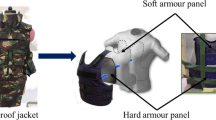Abstract
A hybrid effect with a stiff ceramic plate and strong composite plate has been shown to increase the ballistic performance. However, previous studies have focused only on various hybrid configurations with only qualitative explanation. Such studies have not distinguished the effect of the stacking order from the effect of a projectile deformation such as a mushroom mechanism and inter-layer effect. The current study used a polymeric plate and bullet-proof fabric layer models to identify the stacking order effect of a hybrid panel. Impacts onto a relatively soft fabric layer and a polymeric plate hardly deform the projectile. The gap between the layer and plate can signify only the hybrid effect of the stacking order. Therefore, the hybrid effect when regarding only the stacking order can be analyzed by minimizing the deformation and fragmentation, as well as the inter-layer effect. By conducting numerical simulations in the range of a few hundred m/s impact velocity, it was found that the desirable stacking order can improve a kinetic energy absorption remarkably more than 50%.


















Similar content being viewed by others
References
Ben G, Sugimoto N, Aoki Y (2010) Development of simulation technology for impact behavior of CFRP/Al alloy hybrid beams in side collision of automobiles. Adv Compos Mater 19:363–379
Moon JB, Park YR, Son GS, Kim CG (2017) Computational analysis of a sandwich shield with free boundary inserted fabric at high velocity impact. Adv Compos Mater 26:197–218
Cunniff PM (1992) An analysis of the system effects in woven fabrics under ballistic impact. Text Res J 62(9):495–509
Yang G, Wan X, Hou C (2017) Numerical investigation into ballistic impact response of hybrid woven fabric laminates. In: 2017 8th ICMAE, pp 56–61
Bandaru AK, Vetiyatil L, Ahmad S (2015) The effect of hybridization on the ballistic impact behavior of hybrid composite armors. Compos B 76:300–319
Gopinath G, Zheng JQ, Batra RC (2012) Effect of matrix on ballistic performance of soft body armor. Compos Struct 94:2690–2696
Deng Y, Zhang W, Cao Z (2013) Experimental investigation on the ballistic resistance of monolithic and multi-layered plates against ogival-nosed rigid projectiles impact. Mater Des 44:228–239
Tabiei A, Nilakantan G (2008) Ballistic impact of dry woven fabric composites: a review. Appl Mech Rev 61:010801
Nayak N, Sivaraman P, Banerjee A, Madhu V, Dutta AL, Mishra VS, Chakraborty BC (2012) Effect of matrix on the ballistic impact of aramid fabric composite laminates by armor piercing projectiles. Polym Compos 33:443–450
Martínez-Hergueta F, Ridruejo A, González C, Lorca J (2018) Ballistic performance of hybrid nonwoven/woven polyethylene fabric shields. Int J Impact Eng 111:55–65
Chen X, Zhou Y, Wells G (2014) Numerical and experimental investigations into ballistic performance of hybrid fabric panels. Compos B 58:35–42
Ramadhan AA, Abu Talib AR, Mohd Rafie AS et al (2013) High velocity impact response of Kevlar-29/epoxy and 6061-T6 aluminium laminated panels. Mater Des 43:307–321
Lee BW (2009) Ballistic impact characterization of SiO2 colloidal suspension impregnated fabrics and application to armor systems, Ph.D Thesis, Korea Advanced Institute of Science and Technology
Steinberg DJ (1991) Equation of state and strength properties of selected materials. Lawrence Livermore National Laboratory, UCRL-MA-106439
Na W, Ahn H, Han S, Harrison P, Park JK, Jeong E et al (2016) Shear behavior of a shear thickening fluid-impregnated aramid fabrics at high shear rate. Compos B 97:162–175
Walley SM, Field J (1994) Strain rate sensitivity of polymers. DYMAT J 1994:1–3
Kim YH, Choi CH, Kumar SKS, Kim CG (2018) Behavior of dragon skin flexible metal bumper under hypervelocity impact. Int J Impact Eng 125:13–26
Park Y, Balunch AH, Kim YH, Kim CG (2013) High velocity impact characteristics of shear thickening fluid impregnated kevlar fabric. Int J Aeronaut Space Sci 14(2):140–145
Kim YH, Park Y, Cha JH, Ankem VA, Kim CG (2018) Behavior of shear thickening fluid (STF) impregnated fabric composite rear wall under hypervelocity impact. Compos str 204:52–62
Kim YH, Choi CH, Kumar SKS, Cha JH, Kim CG (2019) Computational analysis of Heracron fabric at high-velocity impact. Compos Res 32(2):120–126
Cavallaro PV (2011) Soft body armor: an overview of materials, manufacturing, testing, and ballistic impact dynamics naval undersea warfare center division. NUWC-NPT Techn Rep 12:1–22
Ahmad MR, Ahmad WYW, Salleh J, Samsuri A (2008) Effect of fabric stitching on ballistic impact resistance of natural rubber coated fabric systems. Mater Des 29:1353–1358
Acknowledgements
This research was supported by Basic Science Research Program through the National Research Foundation of Korea (NRF) funded by the Ministry of Education (NRF-2018R1A6A3A01012712).
Author information
Authors and Affiliations
Corresponding author
Additional information
Publisher's Note
Springer Nature remains neutral with regard to jurisdictional claims in published maps and institutional affiliations.
Rights and permissions
About this article
Cite this article
Kim, Y., Moon, JB., Cha, J. et al. Stacking Order Effect of Hybrid Bumper Against High-Velocity Impact. Int. J. Aeronaut. Space Sci. 21, 95–104 (2020). https://doi.org/10.1007/s42405-019-00189-y
Received:
Revised:
Accepted:
Published:
Issue Date:
DOI: https://doi.org/10.1007/s42405-019-00189-y




